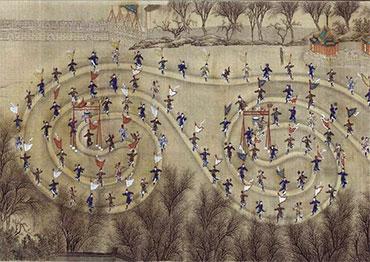In 2005, cave paintings dating back around 10,000-20,000 years depicting hunters on skis were discovered in Altay Prefecture of Northwest China’s Xinjiang Uygur Autonomous Region.
Experts believe that skis like these, made of horsehide and wood, have been in use for more than 10,000 years in the area till today. It is the earliest record of any snow sport in human history.
Fast forward 10 millennia, and pop idol Jackson Yee marvels at the Altay cave paintings in A Date with Snow and Ice, a short film premiered in October 2021 to promote the 2022 Beijing Winter Olympics. He then hits the slopes with skier Gu Ailing Eileen, the American-born freeskier for Team China who went on to win gold for China in the women’s freeski big air event on February 8, silver in freeski slopestyle on February 15 and another gold for freeski halfpipe on February 18.
According to historical records from the Sui and Tang dynasties between the late 6th and early 9th century, tribes of Mongolian and Kyrgyz ancestry rode on wooden boards as they hunted on snowfields. Song Dynasty (960-1279) records mention an “ice game” played by members of the royal court during the winter. But these records do not go into further detail.
During the Qing, China’s last imperial dynasty (1644-1911), ice games were held regularly for military purposes. The Qing was established by the Manchu people from the northern steppes of China’s northeast. Qing founder Nurhaci (1559-1626) organized a special force equipped with ice skates.
The Qing was most prosperous under the 60-year rule of Emperor Qianlong (1736-1796). He was known for indulging in luxury, literature and art. He hosted a winter games event every year in his imperial gardens in Beijing, now open to the public as Beihai Park.
The purpose was to train soldiers, preserve Manchu culture and show the dynasty’s military strength. Tribal leaders and foreign representatives were invited to watch the event.
Emperor Qianlong ordered artists to paint scenes from the event, which he used as illustrations for his essays and poems. The works are the most important resources for academic research today on ancient royal winter games in China. Two of them are kept in the Palace Museum in Beijing.
According to these paintings, Emperor Qianlong’s writings and historical records, at least 1,600 soldiers competed every year in the games, which had three major events. One resembles the modern-day biathlon: soldiers skated and shot arrows at a ball set above a gate near the emperor’s throne. Whoever hit the ball three times won the contest. Another event was speed skating. In one of his essays, Emperor Qianlong described racers going so fast that they resembled “flying bees,” “spooked dogs” and “lightning and meteors.”
The third game was like rugby on ice. A referee threw a ball in the air and two teams scrambled for it. The team that secured possession won, and the emperor rewarded every competitor.
There were also performances that included skate acrobatics, a precursor to figure skating. The “skates” resembled an iron plate tied to wooden shoes. Knee pads were also used.
In the late 19th century, the Qing was controlled by Empress Dowager Cixi, another ruler who indulged in luxury. But by then, the Qing was in decline and the royal winter games had been suspended for years. Instead, she ordered her imperial guards to form an ice-skating team, but only to perform private shows for her.
For one performance, the Chinese character wan (meaning 10,000 – a blessing for Cixi’s long life), and four Chinese characters for “peaceful world” were written on the ice. Then the ice skaters, holding colorful flags, skated along the lines.
Ice sledding has been a popular activity in China’s north. Riders sit on a small wooden bench or chair which were pulled by others or themselves along the ice with short poles. Some fixed iron strips under the seats to make them glide like an ice skate.
The earliest mention of ice sledding was in the Dream Pool Essays, an encyclopedic work compiled in the 11th century by Chinese scientist Shen Kuo during the Northern Song Dynasty (960-1127). During the Ming Dynasty (1368-1644), ice sledding was already a popular winter pastime, often involving alcohol.
Ice sleds were also used for transportation. Wang Youdun, one of Emperor Qianlong’s senior officials, once rode an ice sled from Beijing to Tianjin – a distance of around 125 kilometers. In a poem about the trip, he wrote that the sled went faster than a good horse, and the experience was like “flying in a boat.”
In a painting by Jin Tingbiao, a royal artist during Qianlong’s rule, a group of children ice skate on a pond. They are depicted as laughing at two who had fallen after rushing ahead of the pack.
After the fall of the Qing in 1911, commoners were finally allowed to enjoy the ice of Beihai Lake. Some former imperial ice game athletes would figure skate on Beijing’s other frozen lakes, performing for ordinary people.
Wu Tongxuan was captain of the team who performed at Beihai Lake for Empress Dowager Cixi. He continued to skate there after the fall of the Qing, performing martial arts movements while skating for the crowds. In the 1940s, Jack Wilkes, a photographer for American magazine Life, was sent to China to cover World War II. Among his photos include an old man skating on Beihai Lake. It is believed the man is Wu Tongxuan.
Today, skating, skiing and ice sledding are not only popular in China’s cold north, but across the country. The modern Olympics has taken inspiration from depictions of the Qing Dynasty ice games for the design of the central garden of the Olympic and Paralympic villages in Beijing, bringing the ancient right up to date.

 Old Version
Old Version



